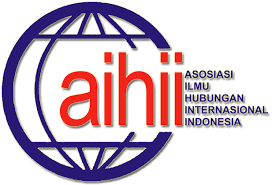The Role of the American Military Industrial Complex in Armed Conflict in the Middle East
Abstract
The Middle East countries, such as Iran, Iraq, Lebanon, Syria, Yemen, Bahrain, Egypt, Turkey, or other countries, seemed to endlessly suffered security and political conflicts. In some countries, the conflict even leads to armed fightings, for example in Iraq, Syria and Yemen. Every day, the medias broadcast the development of the armed conflict in the Middle East, as if telling that this conflict is going to last forever. This phenomenon raises a question, what causes the Middle Eastern conflict to be prolonged? This article addresses the relations between the conflict and the phenomenon of neoliberalism which becomes the main driver of global economy. Using the concept of Military-Industrial Complex, this article argues that there are giant capitalist actors who maintain this condition so they can get huge profits due to the long-drawn armed conflict.
Downloads
References
Brown, C, Browne, R, and Cohen. (2016). Here›s who buys the most weapons from the U.S. CNN [online]. Dalam http://edition.cnn.com/2016/05/24/politics/us-arms-sales-worldwide/ [diakses 2 Mei 2017]
Boas, Taylor C. dan Jordan Gans-Morse. (2009). “Neoliberalism: From New Liberal Philosophy to Anti-Liberal Slogan”. Studies in Comparative International Development, Vol. 44 (2), pp. 137-161
Bouado, Nana Adu-Pipim. (2012). Invasion of Iraq: Instrospective Analysis of US Long Term Policies in the Middle East. Journal of Political Studies, Vol. 19 (2).
Daragahi, Borzou. (2014). War has cost Middle East $35bn, says World Bank. Financial Times [online]. Dalam https://www.ft.com/content/f600d7b6-86d1-11e4-8a51-00144feabdc0 [diakses 19 Des 2016]
Dunlap Jr., Charles J. (2011). “The Military-Industrial Complex”. The Modern American Military. Vol. 140 (3)
Dunne, J Paul dan Elisabeth Skons. (2009). The Military Industrial Complex. Dalam http://arecon.org.uk/DPs/0907.pdf [diakses 10 April 2017]
Editorial Board. (2006). Politics and Conflict in Middle East. Development Issues. Vol. 8 (2)
Eisenhower, Dwight D. (1987). The Military-Industrial Complex. The American Journal of Economics and Sociology. Vol. 46 (2).
Foxnews. (2016). Senate votes to back $1 billion weapons sale to Saudi Arabia. Dalam http://www.foxnews.com/us/2016/09/21/senate-votes-to-back-1-billion-weapons-sale-to-saudi-arabia.html [14 Maret 2017]
Gocer, Sertan Cinardan Ismet. (2014). The Reasons and Economic and Political Consequences of Arab Springs. Khazar Journal of Humanities and Social Science. Vol. 17 (2).
Gilpin, Robert. (2001). Global Political Economy: Understanding The International Economic Order. Princeton: Pricenton University Press.
Helleiner, Eric. (2003). Economic Liberalism and Its Critics: The Past as Prologue? Review of International Political Economy. Vol. 10 (4): 686
IOM Regional Office for MENA. (2016). Migration to, from and in Middle East and North Africa Data Snapshot. Dalam https://www.iom.int/sites/default/files/country/mena/Migration-in-the-Middle-East-and-North-Africa_Data%20Sheet_August2016.pdf [diakses 20 Mei 2017]
Kabir, Abe de Jong Rezaul dan Thuy Tu, Nguyen. (2007). Capital Structure around the World: The roles of Firm-and Country-Specific Determinant. ERIM Report Series Research in Management.
Kapeller, Jakob dan Stephan Puhringer. (2010). Democracy in Liberalism and Neoliberalism: The Case of Popper and Hayek. ICAE Working Paper Series, No. 10.
Karlin, Mark. (2015). US Weapons Industry Profits From Conflicts of Carnage in Middle East. Dalam http://www.truth-out.org/buzzflash/commentary/us-weapons-industry-profits-from-conflicts-of-carnage-in-middle-east [Diakses 2 Jan 2017]
Kone, Amimata M. (2013). The Military-Industrial Complex in the United States: Evolution and Expansion from World War II to War on Terror. Inquiries Journal, Vol. 5 (8)
Kotz, David M. (2000). Globalization and Neoliberalism. Rethinking Marxism, Vol 12 (2).
Lia, Brynjar. (2016).. Jihadism in the Arab World after 2011: Explaining its expansion. Oslo: Department of Culture Studies and Oriental Language University of Oslo.
Lieberfeld, Daniel. (2005). Theories of Conflict and The Iraq War. International Journal of Peace Studies. Vol. 10 (2)
Magen, Amichai. (2013). The Crisis of Governance in the Middle East: Implications for Democracy. Development & Security. Jerusalem: Konrad-Adenauer-Stiftung.
Mehta, Vijay. (2012). The Economies of Killing: How The West Fuels War and Poverty in the Developing World. London: Pluto Press.
Myre, Greg. (2014). America’s Middle East Scorecard: Many Interventions, Few Successes. NPR. Dalam http://www.npr.org/sections/parallels/2014/08/25/341892606/america-s-middle-east-scorecard-many-interventions-few-successes [diakses 2 April 2017]
Marie-Slaughter, Anne. (1995). International Law in a World of Liberal States. European Journal of International Law.
Perlini, Caterina. (2015). Democracy in the Middle East: External Strategies and Domestic Politics. International Relations Insight and Analysis Report , No. 10.
Perlo-Freeman, Sam dan Elisabeth Skons. (2008). The Private Military Service Industry. SIPRI Insights on Peace and Security, No. 2008/1.
Petras, James. (2014). The Soaring Profits of The Military-Industrial Complex, The Soaring Costs of Military Causalties. Global Research [online]. Dalam http://www.globalresearch.ca/the-soaring-profits-of-the-military-industrial-complex-the-soaring-costs-of-military-casualties/5388393 [diakses 3 Maret 2017]
Philips, Janet. (2011). Asylum Seekers and Refugees: What are the facts? Sydney: Parliament of Australia.
Ritzer, George dan Nathan Jurgenson. (2010). Production, Consumption and Prosumption: The Nature of Capitalism in the Age of the digital ‘prosumer’. Journal of Consumer Culture, Vol. 10 (1).
Shamsuz, Zaman. (2015). Rise of the Non-State Actors in Middle East: Regional Dimension. IPRI Journal, XV (1), pp. 51-65.
SIPRI. (2015). The SIPRI Top 100 arms-producing and military services companies in the world (excluding China) in 2015. Dalam https://www.sipri.org/sites/default/files/SIPRI-Top-100-2002-2015.xlsx [diakses 21 Maret 2017]
Stark, Joe dan James Paul. (1983). Arm Sales and The Militarization of the Middle East. Middle East Research and Information Project. Vol. 13
Springer, Simon, et all. (2016). The Handbook of Neoliberalism. New York: Routledge.
Taylor, Peter. (2013). Iraq war: the greatest intelligence failure in living memory. Telegraph [online]. Dalam http://www.telegraph.co.uk/news/worldnews/middleeast/iraq/9937516/Iraq-war-the-greatest-intelligence-failure-in-living-memory.html [diakses 2 Maret 2017]
The Economist. (2013). Chasing Debtors: Cash-strapped Khashoggi? Dalam http://www.economist.com/news/finance-and-economics/21578447-intriguing-twists-and-discoveries-case-against-former-arms [diakses 24 Februari 2017]
United Nations High Commissioner for Refugees. (2017). Facts and Figures about Refugees. Dalam http://www.unhcr.ie/about-unhcr/facts-and-figures-about-refugees [diakses 6 Mei 2017]
Vredesactie. (2014). European arms exports to middle east reach record high in aftermath Arab Spring. Dalam https://www.vredesactie.be/en/nieuws/european-arms-exports-middle-east-reach-record-high-in-aftermath-arab-spring [diakses 1 Mei 2017]
Zifcak, Spencer. (2012). The responsibility to protect after Libya and Syria. Melbourne Journal of International Law, Vol.13 (1).








